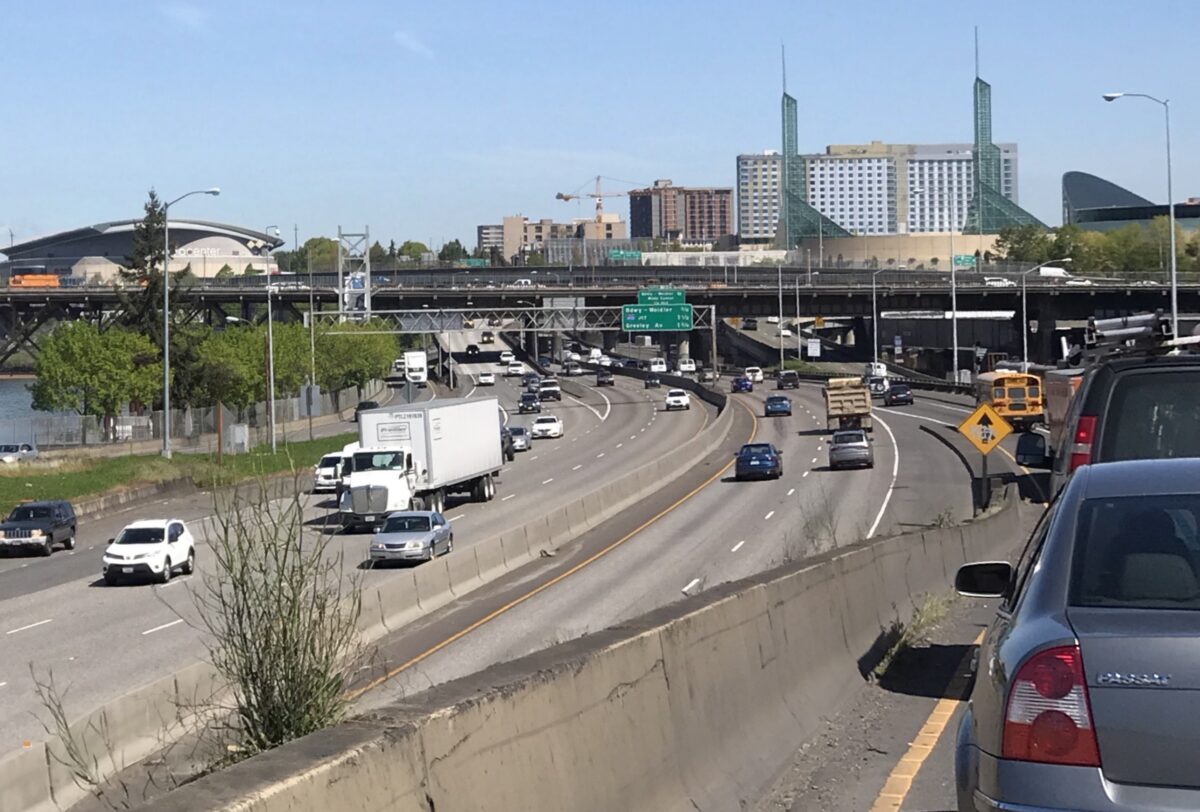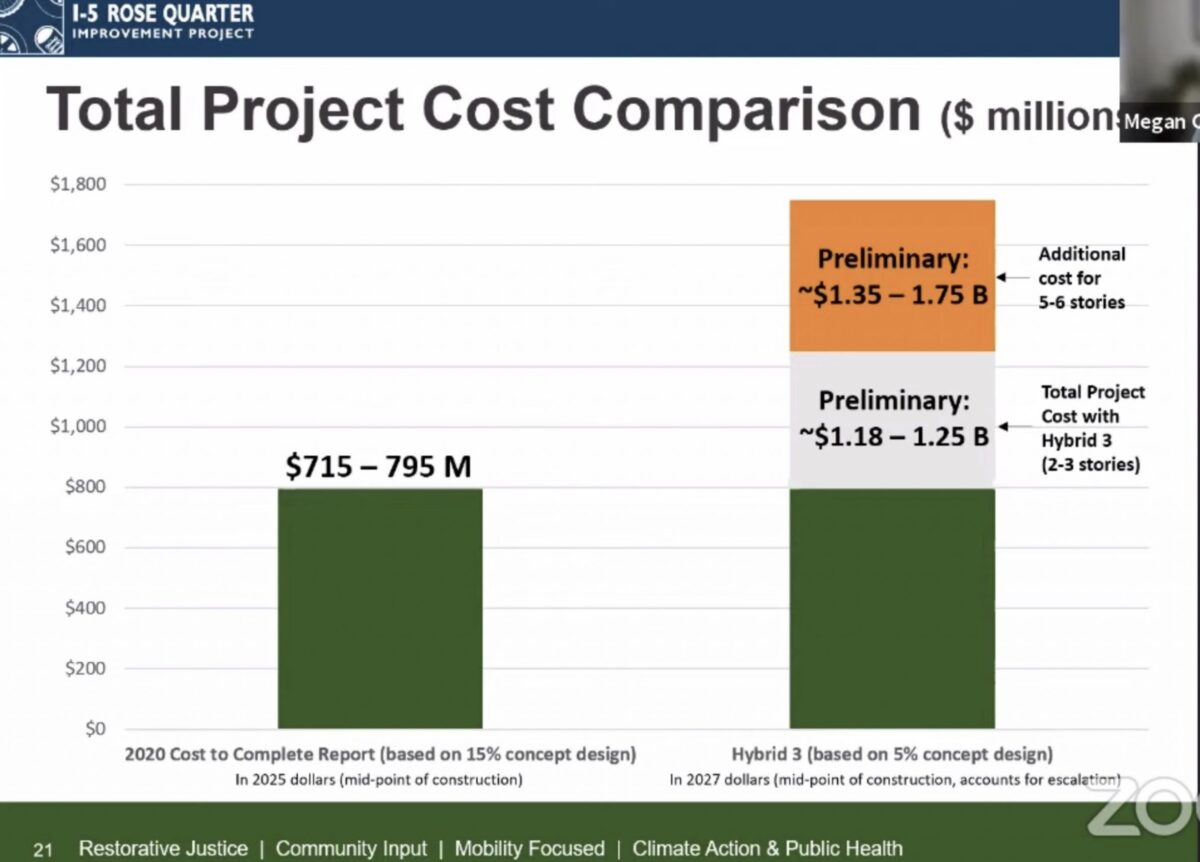
(Photo: Jonathan Maus/BikePortland)
— Transportation is the largest contributor to greenhouse gas emissions in Oregon.
— Transportation has killed 415 people in Oregon so far this year, up over 20% from 2020.
— Oregonians spend more of their income on transportation each year than food, and more than any other expense besides housing.
— How we move around has dramatic impacts on our communities and our social and emotional health.
For all these reasons (and more) we must have responsible leadership from transportation agency leaders and policymakers. Unfortunately we currently have neither.
The Oregon Department of Transportation is full of great people who do important work. But the leadership is literally driving us into oblivion because they refuse to embrace and implement new tools for managing growth and transportation demand. In 2021, they continue to believe adding more driving capacity to our system is the best answer to our problems. Their allegiance to the status quo and to special interests from the construction trades, freight industry, and automobile lobby who profit from it — is very bad for Oregon.
And don’t tell me how they’re working on a tolling program or how they have a Climate Office or how they allocated a record amount of funding to bicycling and pedestrian programs. None of that matters as long as they continue to spend billions to widen freeways.
And ODOT’s bosses at the Oregon Transportation Commission are not coming to save us. They’ve become so enamored with the agency they’re supposed to oversee they’ve become unable — and/or unwilling — to provide leadership.
Advertisement
The two most powerful transportation leaders in Oregon, OTC Chair Bob Van Brocklin and Vice-Chair Alando Simpson, were given a platform to speak on Oregon Public Broadcasting’s Think Out Loud show earlier this week. Host Dave Miller asked them why the I-5 Rose Quarter project cost estimate ballooned from $450 million in 2017 (when ODOT was trying to convince lawmakers to fund it), to $800 million in 2020.
Van Brocklin responded by shirking responsibility, saying that the 2017 estimate happened, “Before I was on the commission.” He acknowledged “a few failures” in that initial estimate and then he said ODOT’s mistake was that they didn’t include the cost of inflation.
“How can you not include inflation in something like this? It just seems like a flabbergasting mistake!” host Miller reacted.
“Well it’s a good question,” Van Brocklin answered. “But I wasn’t on the commission, I wasn’t involved… I don’t think the commission was really engaged at all in that.”
ODOT and the OTC (formerly called the Highway Commission) were definitely engaged in the construction of I-5 in the 1960s when the project tore the heart out of Portland’s Black community in lower Albina. But OTC members want to shy away from responsibility for that as well.
At their September 9th meeting OTC commissioners learned the I-5 highway covers that all parties have agreed on will boost the budget to about $1.2 billion.
While ODOT and the commissioners celebrated the adoption of the “Hybrid 3” cover designs as a major step forward for the project (because momentum is like air for megaprojects – they die without it), they don’t want to pay for it. When ODOT staff presented the cover design at a meeting in mid-August, they singled it out as a “premium” added to the project.
ODOT wants it both ways: They want to trumpet the progress of a cover agreement to give the beleaguered project much-needed inertia; but distance themselves from it at the same time.
A slide (below) of the new cost estimate from project manager Megan Channell was listed as “Hybrid 3,” as if the cover itself was to blame for the expense of the project, and not the freeway lanes or myriad other elements.
Executive Steering Committee member and Oregon Trucking Association President Jana Jarvis heard the dog whistles and made it clear truckers and car drivers shouldn’t to pay for the covers.
So did OTC Commissioner Sharon Smith, who said at their September 9th meeting, “This [building I-5 through a Black neighborhood] was a decision made not solely by ODOT, but by the entire community. City of Portland, the neighborhoods, the whole community. And so when we look at a finance plan to embark on restorative justice, it seems to me that ODOT shouldn’t be the only person, the only agency at the table, helping to right that wrong.”


Also at that meeting, Chair Van Brocklin referred to the new cost estimate as “the Hybrid 3 price”.
That type of language was heard loud and clear by Eric Fruits, vice president of research at right-wing think tank Cascade Policy Institute, who wrote in an op-ed in the Portland Tribune September 23rd, “With the caps demanded by the Albina groups, the project’s cost will rise from its initial price tag.”
To be clear, despite these folks’ attempts to marginalize the covers, there is no project without them. It’s not just “Albina groups” that demand them, it’s every notable elected official in the Portland region, Governor Kate Brown, and two members of Oregon’s Congressional delegation.
This narrative to blame the cost of this project on the highway covers is a blatant attempt to divert attention from the (rightly) controversial freeway widening — an element of the project that somehow manages to avoid the same scrutiny and skepticism from ODOT and OTC commissioners.
Now that several OTC members have gone on the offensive to question whether $400 million on highway covers is the best way to get restorative justice for lower Albina residents, it creates a very revealing contrast to their silence on whether $400 million for more freeway lanes is the best way to fix transportation through the Rose Quarter.
On that last point, at least one OTC commissioner is beginning to have doubts. At that same September 9th meeting where she tried to distance ODOT from the ills of I-5, Commissioner Smith spoke with rare candor:
“Since 2017, a lot of things have changed in our country and our state, and in our communities. We have climate change impacts increasing, we have highway safety getting worse, we have the need for resiliency in our system, we have racial equity concerns, and more emphasis and understanding on restorative justice. And I just wonder if we were to ask the question of the legislature or the state or the citizens: Do you want to spend $1.5 billion on a Rose Quarter project? Is that the best use of our funds right now? And I don’t know if the answer would be yes.
… I just put that out there because at some level, I’m starting to question the viability.”
So are we Commissioner Smith! Please step up and lead us down a different path. The fix for the Rose Quarter should not include more money for the problem (too many cars). We can use congestion pricing and investment in bicycling, walking and transit to reduce demand and free up capacity on the freeway for truck drivers and other essential trips. We can pay for the cover and other elements without widening the freeway.
As David Zipper wrote in a viral Bloomberg City Lab article yesterday (just one sentence after referring to the Rose Quarter project), “If the definition of insanity is doing the same thing over and over and expecting a different result, then these transportation agencies seem certifiably nuts.”
— Jonathan Maus: (503) 706-8804, @jonathan_maus on Twitter and jonathan@bikeportland.org
— Get our headlines delivered to your inbox.
— Support this independent community media outlet with a one-time contribution or monthly subscription.

